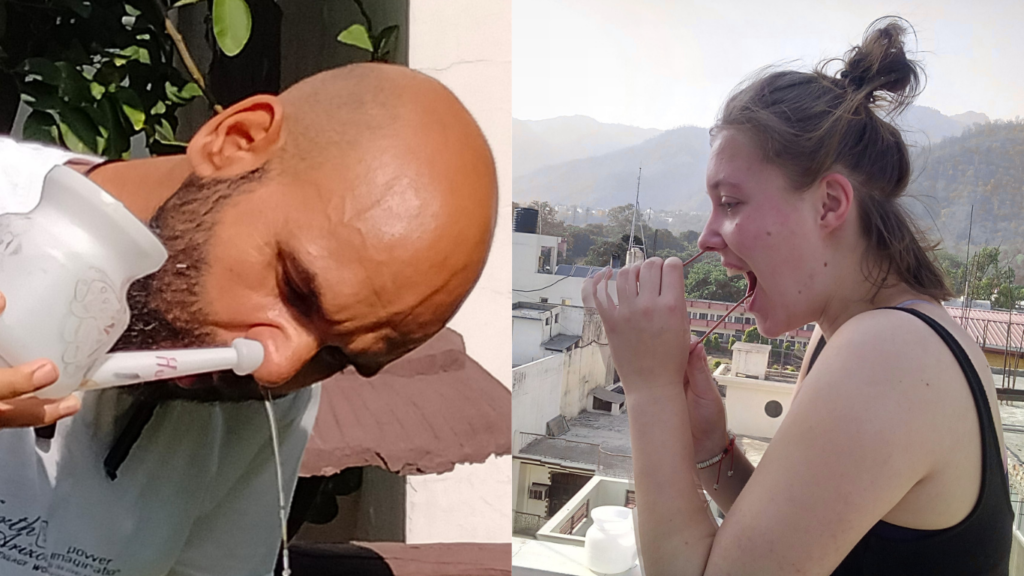Deep study of the yogic cleaning ritual known as dhauti
Soham Yoga School Rishikesh, India
Deep study of the yogic cleaning ritual known as dhauti Shatkarma in yoga is the six main cleansing methods meant to purify the body and ready it for more advanced spiritual activities. Among these, Dhauti is among the most complex and deep purifying techniques aimed at cleaning the gastrointestinal system and surrounding regions.
Dhauti is what?
Deep study of the yogic cleansing ritual known as dhauti. Before, a little bit about the word Dhauti, know. The word Dhauti Coming from the Sanskrit root “dhau,” meaning “to wash or clean,” Dhauti is Among other techniques that clean various interior components of the body—including the alimentary canal (esophagus, stomach, intestines) and the sensory organs— This technique gets the body ready for more complex yoga techniques, aids to eliminate poisons, and boosts digestion. Let’s do a Deep study of the yogic cleaning ritual known as dhauti.

Categories of Dhauti
As depicted in the picture and as stated in classic texts, Dhauti may generally be split into four major classes, each having several forms.
1.Antar Dhauti: Internal Cleansing
Vatsara Dhauti: Swallowing air to purify the stomach.
- Varisara Dhauti: involves consuming plenty of water and passing it through the stools to clear the intestines.
- Agnisara Kriya: Rapid stomach movements to ignite the digestive fire define Agnisara Kriya.
- Bahiskrit Dhauti: In Bahishkrit Dhauti, air is drunk through the mouth and is kept in the stomach for some time and then the stomach is rotated and after that the same air is taken out through the anus.
Antar Dhauti precautions:
- Do not practice on a full stomach.
- Stay away if you suffer from ulcers, heart issues, or gastrointestinal diseases.
- Work under expert supervision, especially Bahiskrit Dhauti.
- Practice first thing in the morning without eating.
- Before and following exercise, make sure you have adequate hydration.
Advantages of Antar Dhauti:
- Thoroughly cleanses the gut.
- Enhances metabolism and digestion.
- Eliminates acid, gas, and poisons.
- Improve abdominal strength and control.
- Boosts general energy levels and vigour.
2.Danta Dhauti:
Danta Dhauti is the cleaning of teeth and the surrounding areas.
- Dantamula: Cleaning the tooth roots and gums.
- Jihva Mula: Root cleaning the tongue
- Karna Randhra: Ear cleaning.
- Kapala Randhra: Cleaning the skull region (foreheadmassage):
Danta Dhauti precautionary steps:
- Apply clean, sanitary instruments (sticks, cloth, fingers).
- Be cautious to prevent gum, tongue, or ear injury.
- Stay away from it if your mouth or ears are infected or have open wounds.
- When cleaning fragile spots, avoid using too much force.
- Cleaning requires gentle and non-irritating materials.
Advantages of Danta Dhauti:
- Encourages dental care and helps to avoid infections.
- Gets rid of mouth bacteria and toxins.
- Encourages face nerves and raises sensory perception.
- Enhances taste sensitivity and stops foul breath.
- Supports general head and neck health.
3.Hrida Dhauti: oesophagus and stomach cleaning
- Kunjal Kriya: Drinking salty water to cleanse the stomach creates vomiting.
- danda dhauti. Putting a soft stick into the oesophagus for cleaning
- Vastra Dhauti: Swallowing and dragging out a long cloth strip cleans the stomach walls.
Preventive Measures for Hrida Dhauti:
- Never practice if you suffer from heart problems, ulcers, or elevated blood pressure.
- When undertaking Dand or Vastra Dhauti, make sure you have oversight.
- If you experience dizziness, pain, or discomfort, stop immediately.
- Avoid overpracticing to avoid causing irritation.
- Make sure all fabric and sticks are sterilised and clean.
Advantages of Hrida Dhauti:
- Removes extra bile and mucus from the stomach.
- Helps digestion and prevents stomach problems.
- Relieves acid, indigestion, and bloating.
- Hardens the diaphragm and oesophagus.
- Improves throat health and respiratory performance.
4.Moola Shodhana, rectal cleaning
Washing the rectum with water or a mild turmeric stick is necessary to maintain anal hygiene and stimulate the lower digestive system.
Moola Shodhana precautions:
- Keep impeccable cleanliness to prevent infections.
- Be kind to prevent harm to delicate tissues.
- Stay away from active haemorrhoids or rectal issues.
- Only use lukewarm, clean water for washing.
- Do not perform if you feel pain or discomfort.
Advantages of Moola Shodhana:
- Preserves rectal cleanliness and wards off infections.
- Activates the lower alimentary tract.
- Aids in alleviating digestive blockages and constipation.
- Supports general colon health.
- Raises pelvic floor strength and function.
🌸Final Ideas from Soham Yoga School
If you want to discover and gain knowledge of the practice of Dhauti, without any harm caused, it is crucial to have a well-informed guru who can show the right way. Soham Yoga School, a place where you can do Yoga Teacher Training, offers Shatkarmas and Dhauti Vasti Kriya in the form of the training courses. It doesn’t matter if you are a start-up level or a broadly experienced person; you are allowed to comprehend these age-old methods in a company and well-organized surrounding.
In our TTC, retreats, and personal wellness programs at Soham Yoga School, we help students through traditional yogic kriyas including Dhauti.

Shatkarma: The Ancient Yogic Cleansing Techniques That Transform…

Neti: The Ancient Yogic Nasal Cleansing Technique for Health & Clarity

How to Do Rajkapotasana (Pigeon Pose)

